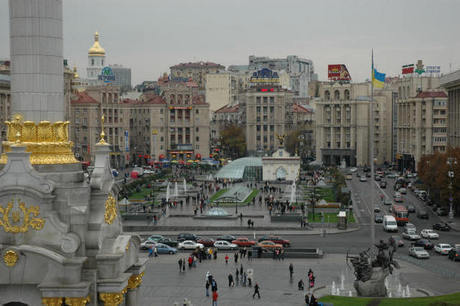Independence Square
The Independence Square, or Maidan Nezalezhnosti, is the central square in Kiev, the main and the most beautiful one. Parades, concerts, festivals and other city arrangements and holidays take place on this square. It contains six fountains, Independence Column and artificial waterfall. The Independence Square has much to offer: the huge building with the tower and chimes, the Trade Union Association Office and other attractions. The left side of the Independence square is covered with granite. One of the main city squares, it is located on the Khreschatyk Street. The square was known under many different names but it became prominent as simply as the Maidan due to the political events that took place there in 2004 after the Ukrainian accession to independence.
"Maidan" literally translates from Ukrainian as square; coming from the Persian word for "square" or "plaza." It received its current name in 1991 in the aftermath of the Ukrainian accession to independence. Nezalezhnist (independence) commemorates the Ukrainian independence achieved in 1991 in the aftermath of the collapse of the Soviet Union.
Throughout its history the square was called by several different names. The area was known since the time of Kievan Rus', but it was not populated or developed until the 18th century, when stone-made fortified walls were constructed. The walls known as Pecherski Gates stood until 1833. Until the late 18th century – early 19th century, the area was a vacant ground known as Goat Swamp (Kozyne Boloto).
In the 1830s, the first wooden dwellings were built, and in the 1850s, stone-made buildings appeared. The most famous Ukrainian writer, Taras Shevchenko was living in that area in 1859, in a building between Small Zhytomyrska and Mykhailivska streets.
The development rapidly intensified after the mid-19th century when the territory gradually found itself in the commercial centre of Kiev that boomed immensely during the Russian Industrial Revolution becoming the third most important city of the Russian Empire.
Until 1871 it was called the Khreschatyk Square; it was a location of the market and folk entertainment. In 1876 the Kiev City Duma building constructed in the square gave the square a new name, Duma Square.
In 1894 the line of the Kiev tram, the first electric tram in the Russian Empire started in 1892, reached the square. In 1913 in the front of the City Duma, a monument of Pyotr Stolypin (who was assassinated in Kiev in 1911) was constructed, which stood there until 1917.
After Ukraine's accession to independence in 1991, the square was given its current name. The competing proposal of Liberty Square (Ploshchad' Svobody) was raised at the time as well as in the years to follow, but the current name commemorating the Ukrainian independence is now firmly associated with the square.
The splendid panoramic view of Old Kiev opens from the upper floors of the square buildings. One can see the domes of Sofia Cathedral built in the 11th century, Andreevskaya Church built in the 18th century, City Parliament, the Central Mall, and a lot of administrative buildings. A great amount of shops, hotels and cafes are situated on the Independence square. Two metro stations, Kreschatik and Maidan Nezalezhnosti, are also situated nearby.
One of the fountains of the square is decorated with statues of legendary brothers Kie, Schek, Horiv and their sister Libed. According to Nikon's Russian Primary Chronicle they chose the place for the city foundation and decided to name it in honor of the elder brother Kie. The sculpture composition on the central square of the Ukrainian capital depicts four founders of the city.
Till the end of the 10th century the site of Independence square used to be occupied by forests. In the 18th century on the plot of land the Pecherskie Gate was put up, but the square still looked like an abandoned lot called Goat Swamp. In 1833 the gate was destroyed, but in the modern pedestrian subway system the basements of the Pecherskie Gate are preserved.
One of the best notable decorations of the central square is the Independency Column topped with a statue of Archangel Mikhail, who is considered to be the saint patron of Kiev. In front of the column, at the end of the square there is an arch decorated with the statue of Archangel with sword and shield. Another attraction of the square is 5,000-sprays fountain called Friendship of Nations designed by architect Komarovsky.
The site of Independence Square used to be the border of Kiev fortified with defense ramparts. Archeologists also found old parts of a water mill there. The first large stone building was constructed on the place in the middle of the 19th century: it was designed by architect Beretti and housed the Province Noblemen' Assembly. In the 20th century the square got its modern look.




